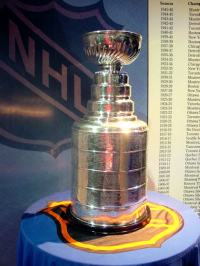The Stanley Cup Playoffs are here in all their glory. Sixteen teams are battling for Lord Stanley’s Cup, and every team wants a fair and equal shot to etch its name into the history books.
I bring up fairness because the rulebook, as well as the methods of upholding those rules, have come under fire in recent days.
For those unfamiliar with the rule, offside prevents a player from “getting ahead of the play.” This prohibits teams from keeping a player in the attacking zone who can receive the puck and have an easy, one-on-one opportunity to score a goal. A player is offside if both of his skates have completely crossed the opponent’s blue line with control of the puck before the puck has completely crossed the blue line.
This rule’s importance has become an integral part of this year’s postseason. To start, this past Friday’s game between the Chicago Blackhawks and the St. Louis Blues just might have been determined by an offside call. The Blues’ Vladimir Tarasenko scored a goal that was reviewed and disallowed since he was offside by the slightest of margins. It is believed that this is one of the smallest-ever margins by which a play was determined offside. The Blackhawks went on to win 3-2 and tied the series 1-1 with that game, so that one disallowed goal becomes a game changer.
Then on Saturday, a similar situation occurred. In the New York Rangers’ 4-2 win, a Derick Brassard goal was reviewed with respects to offside, but it was determined to be a legal play. Once again, the difference between a legal and illegal play was separated by the slightest of margins. It proved to aid the Rangers, but their opponents, the Penguins, wanted that offside call. Once again, the review came at a crucial point, helping the Rangers tie the series at a game apiece.
Lots of fans and analysts have criticized this extreme close-up look when analyzing plays. Many argue that the offside rule was created to prevent blatant violations of staying behind the play. The same people suggest that if a slow-motion camera is needed to determine if the play is offside, it is not shifting any favor to the attacker. This is where I would have to disagree.
The rule for offside is very specifically written and there is a linesman whose sole job is to spot offside. If the NHL puts that much importance in the rule, it has to be upheld to the fullest extent. There have been arguments that this up-close and slow-motion view of plays is favoring the “letter of the law” rather than the “spirit of the law.”
I say, if you have a rule, uphold it. Don’t estimate and don’t try to sweep technicalities under the proverbial rug. Fair is fair, and those who blame the offside rule for ruining a game do not appreciate the how hard of a game hockey is to play. So many sports are games of inches, and the smallest distances can produce a large impact. The rule is the rule, and for better or worse, it must be followed.





